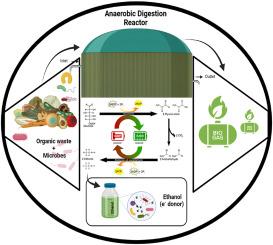乙醇介导的厌氧消化:功能细菌、代谢途径。
IF 8.1
2区 环境科学与生态学
Q1 ENVIRONMENTAL SCIENCES
引用次数: 0
摘要
乙醇介导的厌氧消化(Ethanol-AD)是一种生物过程,它通过分解复杂的有机物将有机废物转化为沼气,沼气主要由甲烷(CH₄)、氢气(H₂)和二氧化碳(CO₂)组成,而乙醇则是中间代谢产物。乙醇作为种间电子传递的电子前体,可提高复杂有机废物的消化率,从而提高沼气产量。乙醇还可作为乙酸菌或合成细菌的底物,而乙酸氧化则会形成乙酸盐,甲烷菌可消耗乙酸盐生成甲烷。甲烷生成是厌氧消化的最后一步,也是关键一步,在这一步中,甲烷菌通过各种代谢途径产生甲烷,其中最主要的是通过富氢途径和合成途径。在嗜氢甲烷发生过程中,甲烷菌消耗氢作为电子前体,消耗二氧化碳作为电子受体,从而产生甲烷。另外,合成营养型甲烷发生的效率也日益得到认可,它主要通过合成伙伴之间的 DIET 进行,而不需要氢作为媒介。这种电子传递模式加强了微生物之间的代谢合作,促进了更高效的甲烷生成过程。随着研究人员继续探索 DIET 的内在机制和(半)导电材料的作用,有可能通过推进甲烷生成过程和提高沼气质量来优化厌氧消化(AD)系统,从而生产可再生能源。本综述的新颖之处在于它对乙醇介导的厌氧消化中的直接和间接种间电子传递(DIET和IIET)进行了双重探讨。虽然之前已经讨论过乙醇驱动系统中的直接和间接电子传递,但本综述是首次全面研究直接和间接电子传递机制之间的相互作用,为优化微生物相互作用和提高甲烷生产效率提供了新的见解。本文章由计算机程序翻译,如有差异,请以英文原文为准。

Ethanol-mediated Anaerobic Digestion: Functional Bacteria and Metabolic Pathways
Ethanol-mediated Anaerobic digestion (Ethanol-AD) is a biological process that converts organic waste into biogas, predominantly composed of methane (CH₄), hydrogen (H₂), and carbon dioxide (CO₂), through the breakdown of complex organic materials while ethanol is an intermediate metabolite. Ethanol improves the digestion of complex organic waste by serving as an electron precursor for interspecies electron transfer, leading to enhanced biogas production. It further serves as a substrate for acetogens or syntrophic bacteria, while mean its oxidation leads to acetate formation, which methanogens can then consume to generate methane. Methanogenesis, the final and crucial step in the anaerobic digestion in which methanogens produce methane through various metabolic routes, most notably via the hydrogenotrophic and syntrophic pathways. In hydrogenotrophic methanogenesis, methanogens consume hydrogen as an electron precursor and carbon dioxide as an electron acceptor, leading to methane generation. Alternatively, syntrophic methanogenesis, which is increasingly recognized for its efficiency, is dominated by DIET between syntrophic partners, bypassing the need for hydrogen as a mediator. This mode of electron transfer enhances the metabolic cooperation between microbes, facilitating a more efficient methanogenesis process. As research continues to explore the mechanisms underlying DIET and the role of (semi) conductive materials, there is potential for optimizing AD systems for renewable energy production by advancing the methanogenesis process, and enhancing biogas quality. The novelty of this review lies in its dual exploration of direct and indirect interspecies electron transfer (DIET and IIET) within ethanol-mediated anaerobic digestion. While DIET in ethanol-driven systems has been previously discussed, this review is the first to comprehensively examine the interplay between both direct and indirect electron transfer mechanisms, offering new insights into optimizing microbial interactions and improving methane production efficiency.
求助全文
通过发布文献求助,成功后即可免费获取论文全文。
去求助
来源期刊

Chemosphere
环境科学-环境科学
CiteScore
15.80
自引率
8.00%
发文量
4975
审稿时长
3.4 months
期刊介绍:
Chemosphere, being an international multidisciplinary journal, is dedicated to publishing original communications and review articles on chemicals in the environment. The scope covers a wide range of topics, including the identification, quantification, behavior, fate, toxicology, treatment, and remediation of chemicals in the bio-, hydro-, litho-, and atmosphere, ensuring the broad dissemination of research in this field.
 求助内容:
求助内容: 应助结果提醒方式:
应助结果提醒方式:


